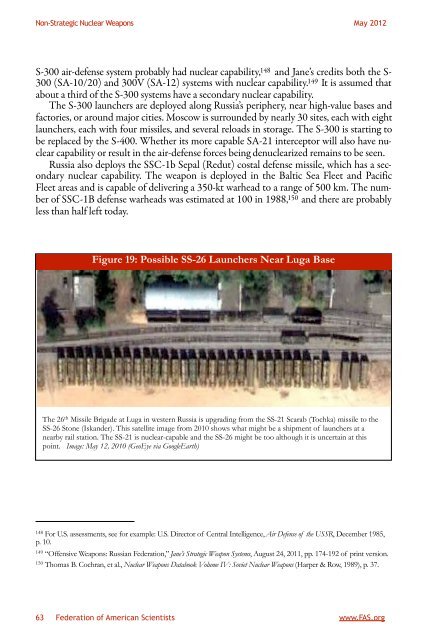Non Strategic Nuclear Weapons - Federation of American Scientists
Non Strategic Nuclear Weapons - Federation of American Scientists
Non Strategic Nuclear Weapons - Federation of American Scientists
Create successful ePaper yourself
Turn your PDF publications into a flip-book with our unique Google optimized e-Paper software.
<strong>Non</strong>-<strong>Strategic</strong> <strong>Nuclear</strong> <strong>Weapons</strong> May 2012<br />
S-300 air-defense system probably had nuclear capability, 148 and Jane’s credits both the S-<br />
300 (SA-10/20) and 300V (SA-12) systems with nuclear capability. 149 It is assumed that<br />
about a third <strong>of</strong> the S-300 systems have a secondary nuclear capability.<br />
The S-300 launchers are deployed along Russia’s periphery, near high-value bases and<br />
factories, or around major cities. Moscow is surrounded by nearly 30 sites, each with eight<br />
launchers, each with four missiles, and several reloads in storage. The S-300 is starting to<br />
be replaced by the S-400. Whether its more capable SA-21 interceptor will also have nuclear<br />
capability or result in the air-defense forces being denuclearized remains to be seen.<br />
Russia also deploys the SSC-1b Sepal (Redut) costal defense missile, which has a secondary<br />
nuclear capability. The weapon is deployed in the Baltic Sea Fleet and Pacific<br />
Fleet areas and is capable <strong>of</strong> delivering a 350-kt warhead to a range <strong>of</strong> 500 km. The number<br />
<strong>of</strong> SSC-1B defense warheads was estimated at 100 in 1988, 150 and there are probably<br />
less than half left today.<br />
Figure 19: Possible SS-26 Launchers Near Luga Base<br />
The 26 th Missile Brigade at Luga in western Russia is upgrading from the SS-21 Scarab (Tochka) missile to the<br />
SS-26 Stone (Iskander). This satellite image from 2010 shows what might be a shipment <strong>of</strong> launchers at a<br />
nearby rail station. The SS-21 is nuclear-capable and the SS-26 might be too although it is uncertain at this<br />
point. Image: May 12, 2010 (GeoEye via GoogleEarth)<br />
148 For U.S. assessments, see for example: U.S. Director <strong>of</strong> Central Intelligence, Air Defense <strong>of</strong> the USSR, December 1985,<br />
p. 10.<br />
149 “Offensive <strong>Weapons</strong>: Russian <strong>Federation</strong>,” Jane’s <strong>Strategic</strong> Weapon Systems, August 24, 2011, pp. 174-192 <strong>of</strong> print version.<br />
150 Thomas B. Cochran, et al., <strong>Nuclear</strong> <strong>Weapons</strong> Databook Volume IV: Soviet <strong>Nuclear</strong> <strong>Weapons</strong> (Harper & Row, 1989), p. 37.<br />
63 <strong>Federation</strong> <strong>of</strong> <strong>American</strong> <strong>Scientists</strong> www.FAS.org
















